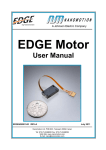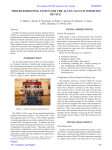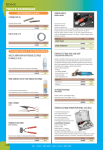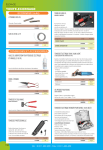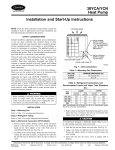Download TUAP019
Transcript
8thInternationalConferenceonAccelerator&LargeExperimentalPhysicsControlSystems,2001,SanJose,California TUAP019 physics/0111208 INSERTION DEVICE CONTROLS AT THE SWISS LIGHT SOURCE T.Korhonen, B.Kalantari Paul Scherrer Institute, Villigen, Switzerland Abstract In the initial phase of the Swiss Light Source (SLS), four insertion devices (ID) will be installed for the first four beamlines. The control system for all the ID’s follows, where possible, a uniform concept to allow a rapid installation schedule, while at the same time allowing for a variety in operational requirements. The components of the control system include the gap drive system with encoders, temperature monitoring, beam position monitoring, power supply controllers for corrector magnets [1] and a timing module [2]. The gap drive system requirements range from micronlevel accuracy to driving double undulators in synchronism with each other and also with the other beamline elements. The local synchronism is achieved with a tightly coupled system having an intelligent motor controller and the global synchronism by extending the machine timing distribution to the insertion devices and the beamlines with the capability to add beamline-specific timing events. The UE56 is an undulator capable of producing linearly and elliptically polarized light. The switching of the polarization mode is achieved by splitting the upper and lower magnet arrays into two halves and having a mechanism move them relative to each other. There are a total of four motors: two for the gap and two for controlling the shift arrays. Two identical IDs will be installed for the beamline and these which have to be controlled synchronously, giving us 8 axes to control. The fourth device is an electromagnetic double undulator UE212. This ID has no moving parts, but the fields are generated by electromagnets. For power supplies for this device we use the standard power supplies of the SLS machine [1]. Very little additional development was necessary, except for the operation of the device in several modes defined for it. These could be implemented as additions on top of the generic SLS power supply control software. 2 1 INTRODUCTION At the SLS, the first insertion devices are a wiggler for the material science beamline, an in-vacuum minigap undulator for protein crystallography, an elliptically polarizing undulator (two identical devices) and a long electromagnetic undulator (two devices.) The core of the control system is specific for each device, but they also have a number of components in common. The first device installed was an in-vacuum undulator (U24) developed in collaboration with Spring-8 in Japan. Its gap drive has a single stepper motor and an absolute rotary encoder. These are controlled through a local controller that has a GPIB bus interface. To integrate it with our control system, we wrote EPICS device support code for that controller in order to poll the status and send commands to drive the gap to a desired position. The common part of the control system and the user interface, however, was developed for this device first and adapted for the others. For the two other permanent magnet devices, namely the wiggler W61 and a double undulator UE56, the gap controller had to be developed in-house. The aim was to design a system that would serve as a basis for the control system of future insertion device development. The wiggler W61 has two motors to control the gap. It was decided to have two motors to be able to control the parallelism (taper) of the magnet arrays. GAP CONTROL Gap control is the centerpiece of an insertion device control system. For the W61 and UE56, the gap control system had to be developed in-house. Although the devices are quite different, we strived to find a common design that could also be used as a basis for future developments. The gap control consists of a drive system to move the magnet arrays and a position measurement system to monitor the distance (gap) between them. The positions are typically measured by encoders. The philosophy was to have a gap measuring device as close as possible to the real mechanical gap. To have a high precision over a quite large range, we decided to use linear incremental encoders manufactured by Heidenhain [4]. The selected encoders (ULS300) have high precision absolute reference marks. This allows high reproducibility of the gap setting. For the motor controller, we selected the Oregon Microsystems OMS58 motor controller card [7]. This card has software support from the EPICS community and is already in wide use at SLS beamline controls. One big advantage is also that this card has support for both servo and stepper motors, with the same software interface, so a large part of the software for both the servo and stepper motor-based systems could be reused. The devices had a number of different requirements: the ability to drive to a fixed setting with open loop control only and real time position hold feedback. In all cases, several 110 8thInternationalConferenceonAccelerator&LargeExperimentalPhysicsControlSystems,2001,SanJose,California motors have to be moved synchronously. For the development of the gap drive we decided to build an “ID test stand”, a mechanical model of an ID with which we could test and debug the control system before having the actual devices. The test system included only the gap drive and the linear encoders; it turned out to be an extremely valuable development tool, especially because the time between ID delivery to PSI and installation was short and the time for control system development very limited. With the test stand the control could be developed without having the actual device. Without the test stand it would have been almost impossible to meet the construction schedule. For the W61, the gap accuracy requirement is not that strict and the movement is only in the gap direction, so it was sufficient to have stepper motors and an open loop control with capability to monitor the linear encoders and, if necessary, do a position correction. The system has two motors that have to run synchronously to keep the taper, i.e., the inclination angle of the magnet arrays, close to zero. To have a protection in the low level we built a controller with a PLC to act as an interface between the power drive system and the control system. The PLC monitors that both motors are running and that the taper does not get too large. It stops the drives if there is a problem. The foreseen operation mode for the wiggler is to be driven to a gap value and left there for a long period of data taking during the experiment. For this reason, there were no requirements of closed loop control; an open-loop control with stepper motors is adequate. The system can be controlled with high resolution by correcting the position with the help of the linear encoders. The UE56 has more demanding requirements. The device has the ability to change the light polarization from linear to elliptical by shifting the upper and lower magnet arrays relative to each other. The large magnetic forces push mechanically the gap open when the shift arrays are moved. The difference is measured to be about 300 microns, which is not acceptable for operation. The system required closed loop position control, with four axes. The drive system uses AC servo motors. The conventional way would be to use rotary encoders on the motors for the position feedback, but to ascertain the required high precision, we decided to do the feedback directly from the linear encoders. This is more difficult to tune, because the whole system is included in the feedback loop and the components cannot be individually tuned. However, this simplifies the additional software because the regulation is directly based on the gap and no corrections for the effects of the mechanical elements in between (like backlash, bending, creep) are required. Like for W61, a PLC system for low-level local control was developed. This time an external company implemented our specifications. Two identical devices will be installed for the beamline. The reasons for having two devices are first to have a larger photon flux, and to have a fast switchable polarisation selection available. The switching is achieved by steering the beam horizontally a little apart through the undulators, putting them into different polarization modes and then hav- ing a mechanical beam chopper to select one of the two photon beams. In this mode, the two undulators have to be controlled as a single device. We have achieved 1 micron precision and repeatability for the UE56 gap drive. The polarization mode can be changed dynamically and the feedback keeps the gap value constant regardless of the highly nonlinear magnetic forces from the magnet array shifts. 3 ADDITIONAL SYSTEMS For the operation of the insertion devices, additional monitoring systems are necessary to guarantee the safety of the operation and to optimize the performance. 3.1 Beam Position Monitors (BPM) For monitoring the beam position close to the insertion device, we use a separate beam position monitor system, consisting of pickups, a BPM processing module (Bergoz) [3] and a (SLS standard) ADC to record the positions. The main purpose of these BPMs is to provide signals to an external interlock system that could dump the beam if the beam orbit had a large offset or a large angle at the insertion device. These BPMs have proven very valuable to monitor the effect of the ID on the beam because they are situated close to the ID and give direct information about the beam orbit at that point. Further study is necessary to fully understand the behaviour and calibration of these BPMs. 3.2 Beam Loss Monitors Beam loss monitors have been installed near the insertion devices. Especially critical is the U24 in-vacuum undulator. For that there are large area scintillators. The scintillators are very sensitive and have a fast response. They have been proven to be very useful for commissioning. The output from the beam loss monitors is pulses with the frequency giving the loss rate. The pulses are read out with a (SIS [6]) multichannel scaler into EPICS channels. 3.3 Temperature measurement Monitoring of the vacuum chamber temperature is a safety measure against heating when the orbit is bad, or, as in the case of the in-vacuum undulator also serves as an indicator of possible problems in the cooling system. In this device, the control program constantly monitors the temperature and if it rises over a specified threshold, the gap is automatically opened. The temperatures are measured with thermocouples and Greenspring [5] thermocouple IP (Industry Pack) cards. For U24 we can also monitor the cooling system through a serial port interface. 3.4 Correctors Each insertion device has horizontal and vertical corrector magnets placed close to the device upstream and downstream. These correctors are used to minimize the effect 111 8thInternationalConferenceonAccelerator&LargeExperimentalPhysicsControlSystems,2001,SanJose,California of the residual kicks from the ID at different settings. The corrector values for each gap setting follow breakpoint tables that have been measured during commissioning of each device. At the time of writing, the detailed implementation of these lookup tables for the UE56 is still partially open because there are two parameters: the gap and the polarization mode (magnet array shift.) Both of these have an effect of the orbit. We need two- (or perhaps even three-) dimensional lookup tables to fully implement the automatic correction. 3.5 Synchronization In the future the insertion devices should be operated in synchronism with the other beamline components. In most cases this can be achieved simply with EPICS Channel Access. A method for tighter synchronization is foreseen with an extension of the machine event distribution system to the beamlines. Although the main interest of tight synchronization is in the experimental stations, the extension is done in the ID system by putting an event generator in the ID crate. In this way, additional events that are specific to each beamline can be generated by accessing the event generator. An example would be a sequence of movements that could be pre-loaded to the beamline control IOCs and synchronously triggered by sending the events from the ID control system crate. 4 THE SOFTWARE The control system is implemented in EPICS, using mostly readily available driver and device support modules plus standard records. So far, all the functionality could be achieved without having to modify any of the low-level components (record types etc.), except, of course, writing device support for cards that do not have it already. 4.1 User Interface Although the devices are very different, much effort has been taken to make them look similar to the operator and to hide the different levels of complexity behind a common operating interface. Basically, only a minimum of information is normally presented. The operator normally can only switch on or off the drives and to set the gap to the desired value. For instance, before turning on the power the devices go internally through a series of checks and settings (the gap setpoint is synchronised with the actual gap value, for instance) before the motor power is turned on. At the time of writing the devices are still considered to be in commissioning and the user interface is rather rudimentary. In the future, however, it will become increasingly important that the beamline components are aware of each other and can be controlled as one system. For this, it is required to agree on the method and rules of communication between the component control systems. The fact that all the beamline components are controlled with EPICS eases the integration. The regular operation when a device is set to a certain gap/energy value is straightforward. The system will get more complicated when we want to do synchronised scans, i.e., operate the beamline monochromator in sync with the insertion device. Since the monochromator and the gap control are fairly slow devices, the synchronization is easily achieved with EPICS Channel Access over the network. 5 CONCLUSIONS We have initially commissioned all the four types of planned insertion devices at SLS. Although work still remains to be done to finalize the operator interface and debug and calibrate the components, the concept has proven to work quite well and fulfills all the requirements. Two big factors that contributed to its successful development were the strong support and availability of software from the EPICS community, and the fact that we were able to standardize our control hardware to a large extent and could reuse the elements and we also had an extensive in-house expertise with the components. One big factor was having built a “test stand”, a mechanical model of an insertion device, with the ability to simulate (nonlinear) magnetic forces. Using the test stand we could develop the gap drive system before the devices were available for testing; this gave us almost one year of lead time before the delivery of the device. When the real device arrived, testing and commissioning could proceed smoothly without big surprises. 6 REFERENCES [1] A.Luedeke et.al.,’Digital Power supplies for the Swiss Light Source’, ICALEPCS’01, San Jose, California, USA. [2] T. Korhonen, M.Heiniger, ’Timing System of the Swiss Light Source’, ICALEPCS’01, San Jose, California, USA. [3] Bergoz SA., “BPM system user’s Manual” [4] Heidenhain GmBH. www.heidenhain.com [5] SBS Greenspring, www.greenspring.com [6] SIS GmBH. www.sis.de [7] Oregon Microsystems, Co.. www.omsmotion.com 4.2 Integration to the beamline The devices have been operated as independent units without any direct connection to the corresponding beamline. 112






